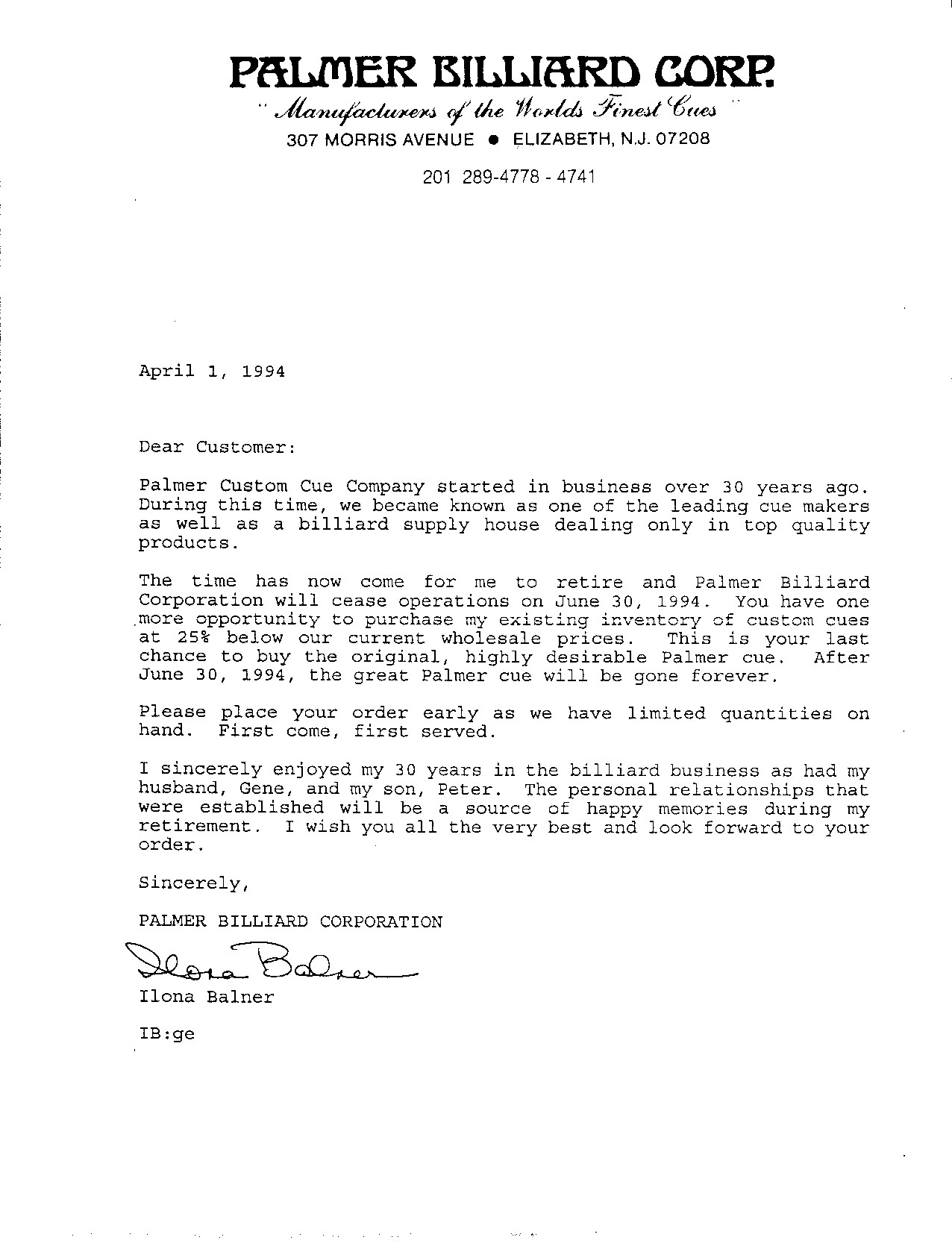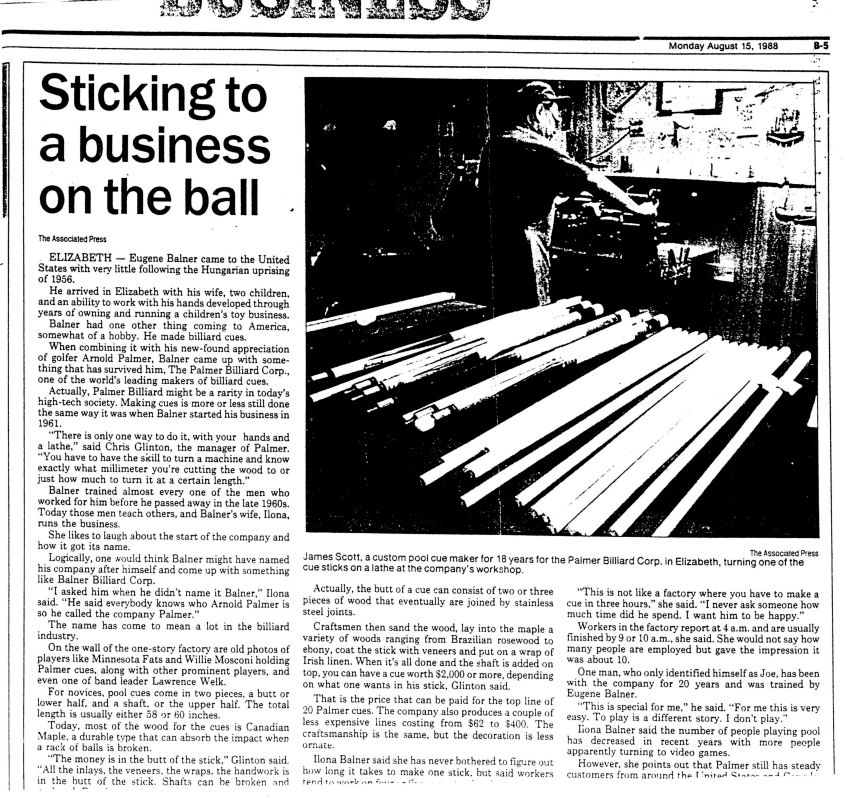
- The Palmer Collector -
Palmer Custom Cues , History Part 2
Part 4: Tragedy & Triumph, 1971 - 1994
Tragedy struck on January 7, 1971, when Eugene Balner passed away. It was a fearful and challenging time for Peter and Ilona, but they rose to the occasion. They were fortunate to have a skilled and reliable shop foreman, Mike Katsiris, who was with them from the early days. Mike was able to supervise every facet of shop activities including building their own veneered forearms. He also had a stable and reliable crew of skilled woodworkers. Ilona continued to do the inlays and fine work.
Despite the setback, the Third Catalog was introduced in the 1970's after Eugene's demise. The new line consisted mostly of modifications and improvements to earlier successful styles, although they introduced the 8 prong cue (model 19) and the most famous Palmer of all time, the famed Model 20 with the inlaid shafts.
The writing was on the wall, however, as Palmer introduced a general supply catalog with billiards products and accessories. The company was becoming a distributor and retailer of manufactured products and was moving away from custom cue building. In the mid 1970’s, Peter Balner was convinced by David Forman of Sutra Import Corp, and later Adam Custom Cues Co., to try some of their forearms. Palmer began using these high quality forearms made exclusively for them by Dick Helmstetter in his Japanese factory. In the late 1970’s they introduced the PB Line (which stood for Palmer Billiards) and PM Line (Pete Margo). Pete Margo was a pro player and good friend of Peter Balner. The inexpensive PM line and mid level PB line were manufactured by Adam, Japan to the designs and specifications of Palmer. These were followed by the higher end Bullet series in the 1980’s which were made by Palmer. Additionally, Palmer kept the custom shop open and would make Old Line cues well into the 1980's using updated parts available from other lines.
In 1981, Peter Balner laid plans for Palmer to become an even larger player in the custom cue niche. Instead, he was convinced by Pete Margo to take a look at the video business. He did, and they became partners in Palmer Video, leaving Ilona in charge of Palmer cue. They were very successful and sold their 46 stores and 300 franchised locations to West Coast Entertainment in 1996.
This marked the heyday of Palmer cues, one of the most successful custom cue makers, innovators, and marketers in billiards history. Peter Balner is now retired and enjoying life, and his mother, Ilona, is a spry woman of 84 and doing well.
Sadly, in 1994, after 30 successful years in the Billiards industry, Palmer Billiard Corp. closed its doors. Their equipment was sold to Blatt Billiards in New york, and so ended a chapter in the Golden Age of custom cue-making history.
A Brief History of the Palmer Custom Cue Company, continued...
Part 3: The Palmer Age, 1968 - 1971
Before the “Second Catalog” was introduced, there was a model card distributed featuring some of these designs. There was considerable demand for the new styles. Customers kept asking for a simple cue, like the old Rambows. Eugene designed the Model “C” to accommodate them and called it Rambow-style, creating what today is referred to as a “tribute cue”. Eugene also designed the H cue, with a classic bevel edge pearl name plate with veneers, and the most famous of all Palmer designs, the Model “M”, with it’s wavy veneers running all over the cue.
Peter Balner designed the remainder of the line including the beautiful model “J”, the elaborate “K” and the elegant “I”. Many of the cues were updates from the first catalog, but the “Second catalog” was really all about the new designs.
In the late 1960’s, Palmer was dealing in larger and larger volumes. Palmer was a major purchaser of Irish Linen supplied by the Cortland Line Company and sold to all the cue makers including George Balabushka, Dick Black and Gus Szamboti. As a major customer of Cortland, Palmer convinced them to make the first multi-colored linen besides the standard white with green spec. Palmer also sold other cue parts, such as ivory ferrules, stainless steel joints, plastics, and nylon wrap material to the other cue-makers. George Balabushka was a frequent visitor and purchased his shaft wood from them because he could pick through Palmer’s large inventory.
The demand for cues in the 1960’s through the 1970’s put great pressure on management. Production increased significantly. The supply of discarded house cues used on the bar cue styles was no longer enough. Palmer contracted with a quality house cue manufacturer, Irving Katz, located in Brooklyn, NY, for blanks, buying thousands at a time. Brunswick also supplied the Titlist blanks, which Palmer bought in thousand blank shipments.
Palmer made many of the forearms in house, especially for the premium cues. In the later 1960’s they bought several hundred blanks from Burton Spain, but his inability to supply Palmer in sufficient quantify lead them to seek others, and a connection was made with Gus Szamboti. Peter came to know Gus well and had deep respect for his work ethic and quality standard. Gus continued to supply Palmer for many years to come.
Palmer outsourced many things, and bought from quality suppliers, but they always built the first through third catalog cues themselves until well into the 1980’s. Every “M” cue made by Eugene Balner. He was the only one with the skill to execute the cuts into the rock hard African ebony.

